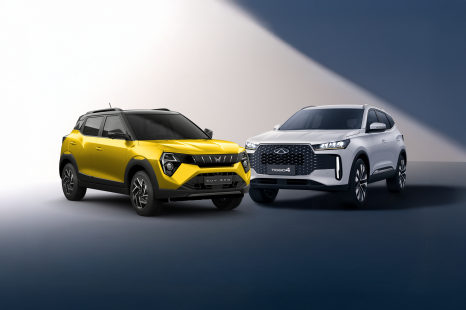

Andrew Maclean
2025 Mahindra XUV 3X0 vs Chery Tiggo 4: Spec battle
1 Month Ago
This is a Hyundai you won't miss on the road. The Ioniq 5 is all-new and sits on a dedicated EV platform. Could it be the EV that gets you across the line?
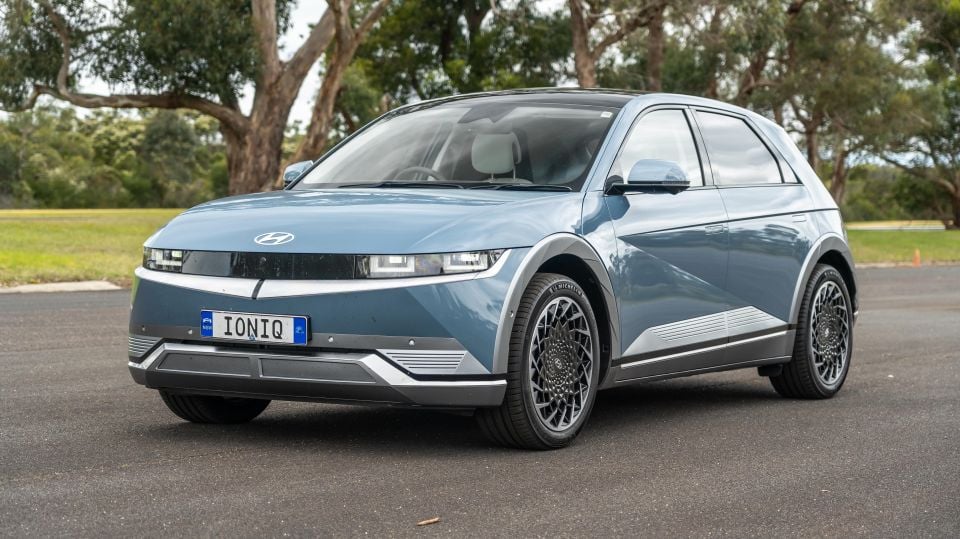
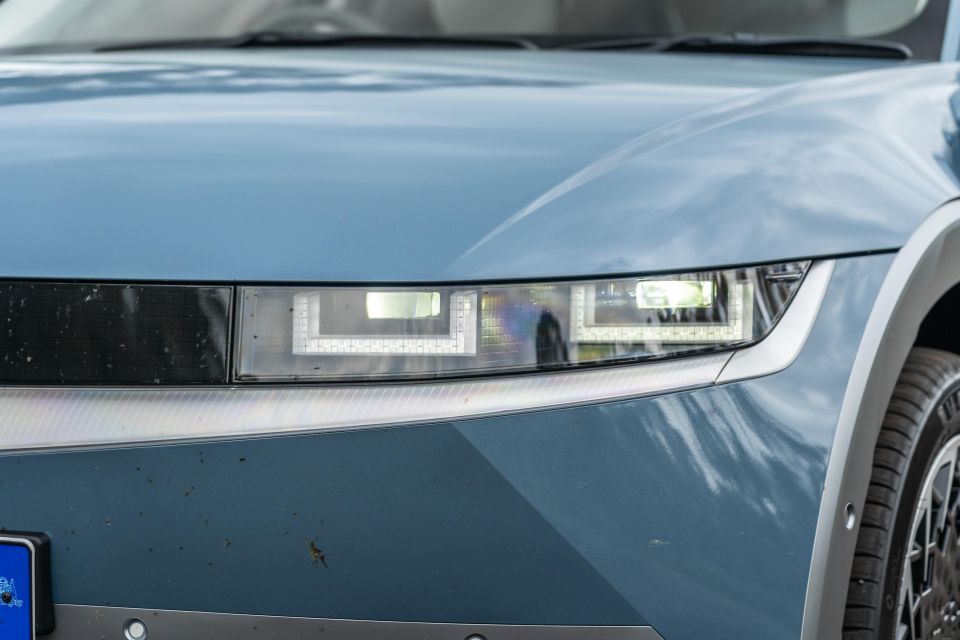

Founder

Founder


Founder

Founder
Where expert car reviews meet expert car buying – CarExpert gives you trusted advice, personalised service and real savings on your next new car.
I love my job and I’m always excited by new models, but the all-new Hyundai Ioniq 5 is a car I’ve been hanging out to drive all year.
Not only does the design look completely different to anything else on the road, but it sits on a new platform for Hyundai dedicated to electric vehicles, which means it should in theory be markedly better than anything electric the manufacturer has produced to date.
With a huge shift in focus to electric vehicles (EV) globally, it’s arguably a very important product for Hyundai and one that it needs to get right.
As the owner of a Tesla Model 3 and the father of a new baby, we’re also looking for something bigger. So I’m not only reviewing this from the point of view of it being a new car, but also from the point of view of needing a bigger car and wanting it to be an EV.
Hyundai is selling the Ioniq 5 direct to customers, which means buyers will bypass dealers when it comes to ordering their new car.
Available in two variants at launch, the Ioniq 5 kicks off from $71,900 before on-road costs for the entry-level Ioniq 5 2WD, with the top-specification Ioniq 5 AWD priced from $75,900 before on-roads.
The initial allocation for Australia of 240 units has now been sold out, with all new orders slated for a 2022 delivery. Hyundai Australia has also indicated further variants will be added to the local range in future.
There are six colour options available. All are free of charge except matte colours, which attract a $1000 surcharge.

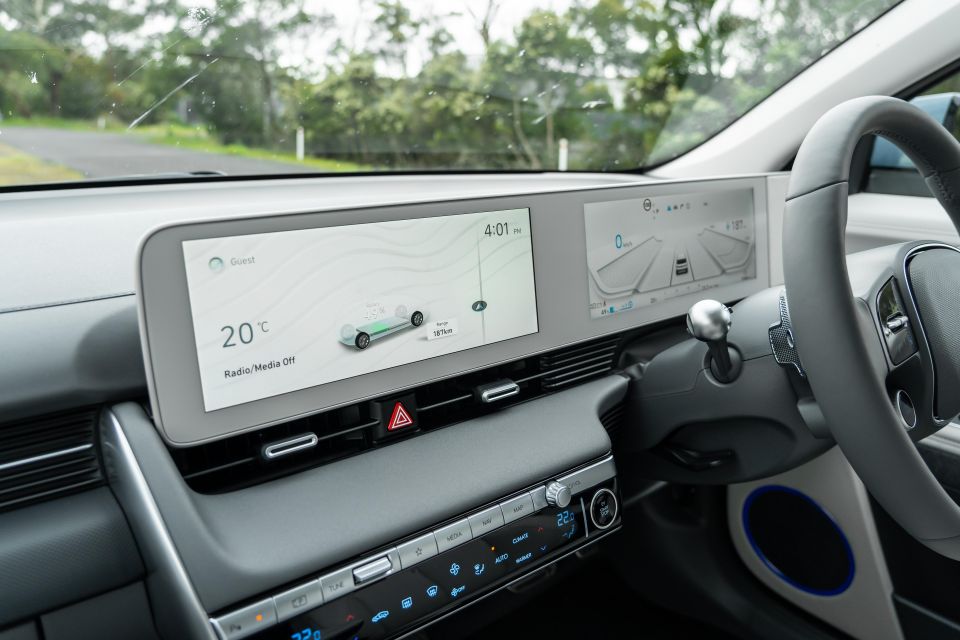
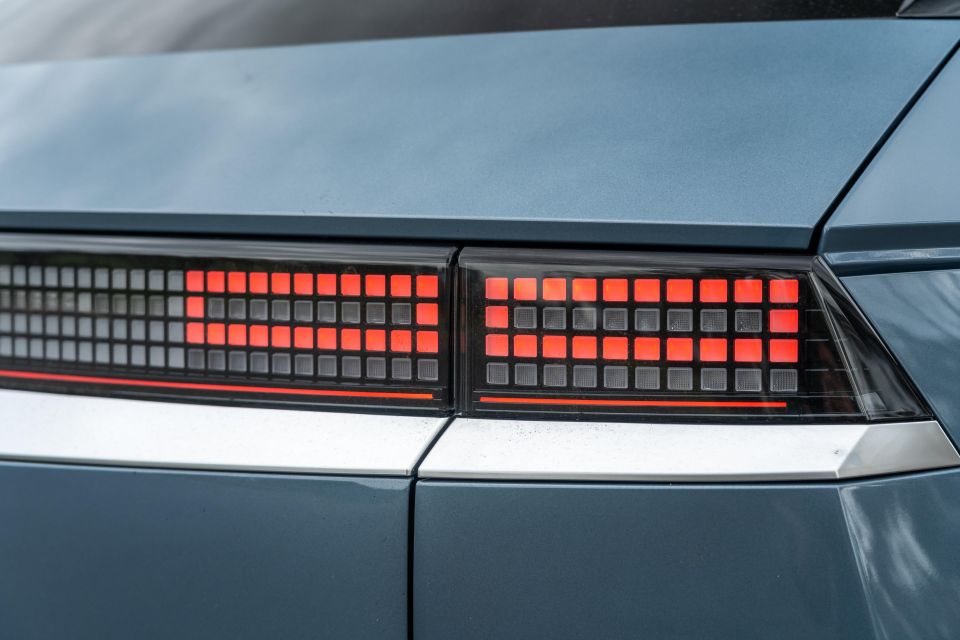
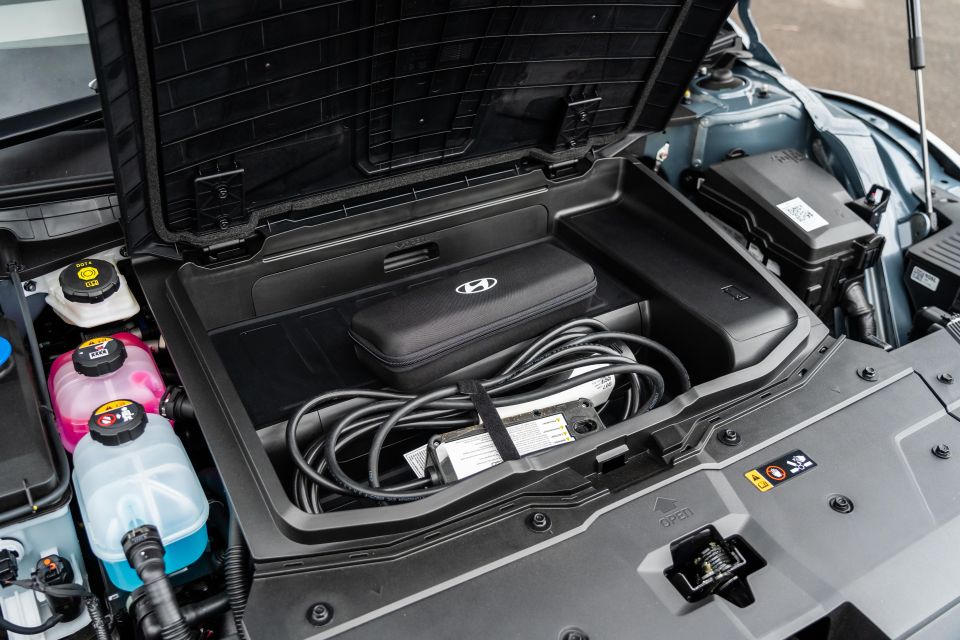
Australian-delivered Hyundai Ioniq 5 vehicles come loaded with all the fruit. While electric vehicles are typically more expensive than their internal-combustion counterparts, Hyundai has eased the pain by throwing the feature book at the vehicle.
Standard equipment includes:
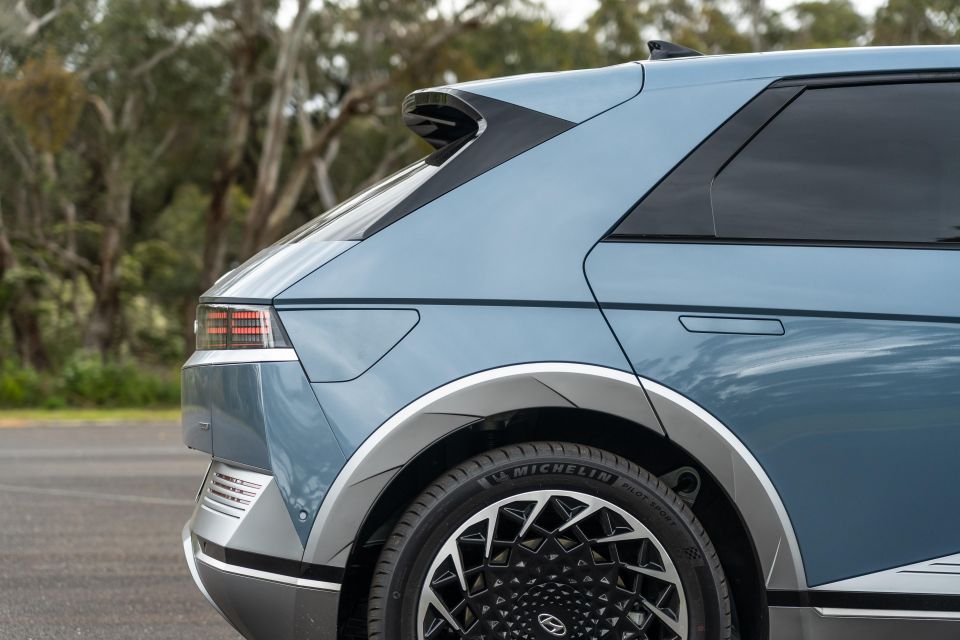
The Hyundai Ioniq 5 has yet to be tested by ANCAP or Euro NCAP.
Standard safety equipment includes:
The autonomous emergency braking feature, which Hyundai calls Forward Collision-Avoidance Assist, includes the following functionality:
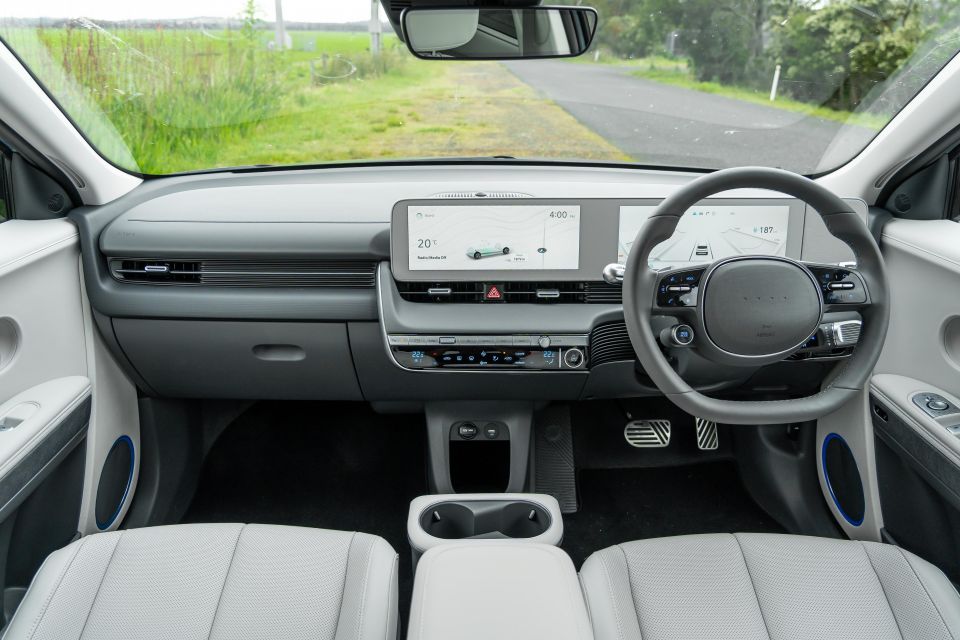
This could be a good thing or a bad thing depending on what you think about Hyundai interiors, but when you open the Ioniq 5’s door it looks unlike any other Hyundai.
The steering wheel looks like it was taken out of a more upmarket Genesis product, while the rest of the interior and switchgear has been simplified as much as humanly possible without detracting from functionality.
There are also some cool easter eggs hidden around the place – you’ll notice a plus and minus symbol on the throttle and brake pedals respectively. The pad to the right of the driver information display features a magnetic pad for attaching photos, while a large number of trims in the cabin are made from recycled materials.
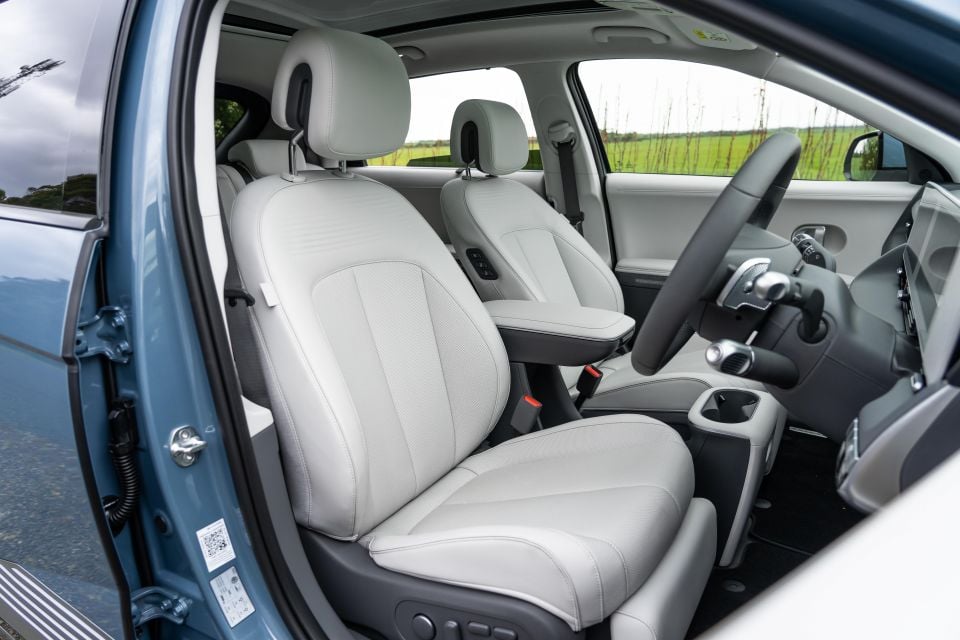
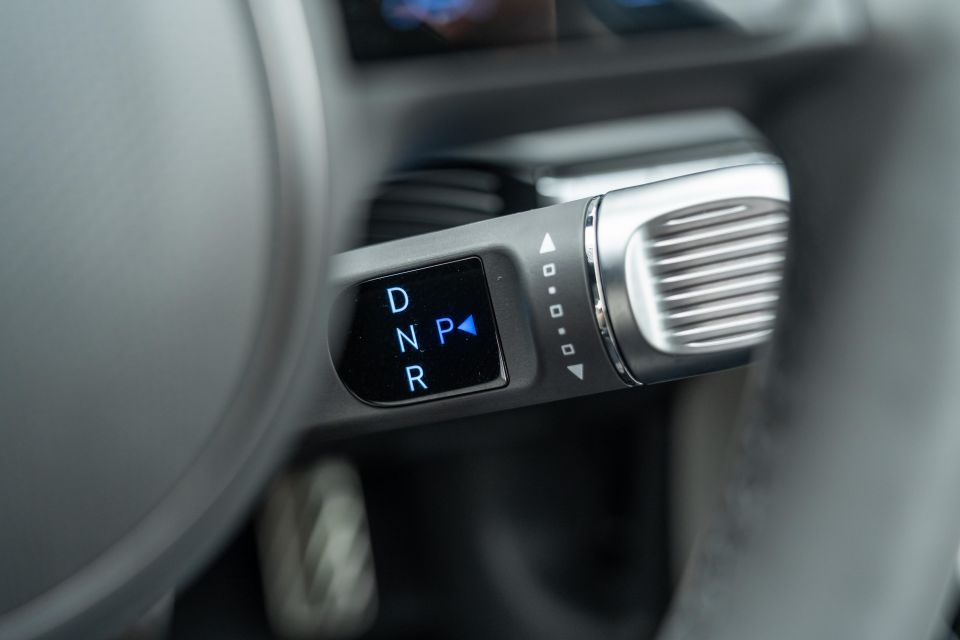
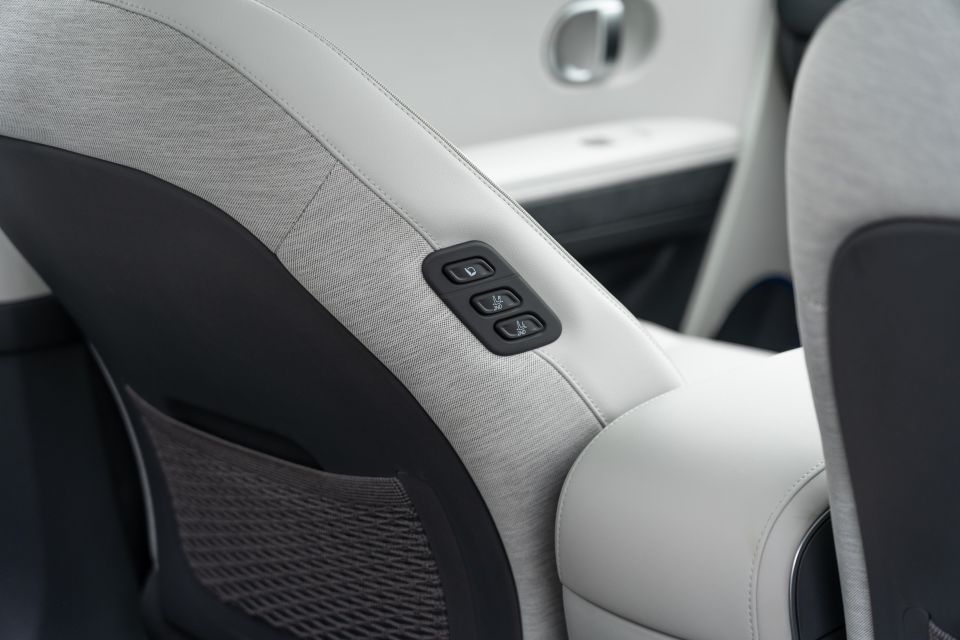
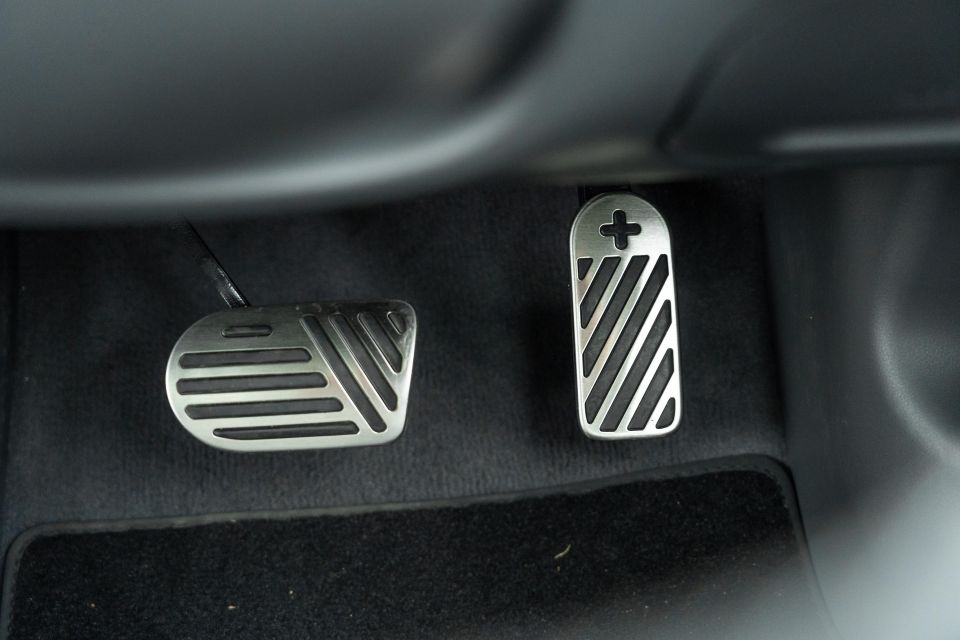
Functionality was also key to making this interior work, which is why the centre console can slide forwards and backwards to offer more storage space. The driver and front passenger seats can fully recline with an extending leg rest, designed to give you a relaxing place to wait while the vehicle charges.
The glovebox is a big bin as opposed to the cramped space you see in most cars. The passenger seat features controls the driver can access to electrically shift the second row to increase boot space. These are just a few of the little things Hyundai has done to make this car as practical as possible.
Interior space feels vast. That’s thanks to the Ioniq 5’s dimensions. It’s longer and wider than a Toyota RAV4 (just to give you an idea of its size) and the wheelbase is longer than Hyundai’s biggest SUV, the Palisade. This means the cabin feels big and spacious – especially for second row passengers.
Toe room is compromised by the base of the front seats, but for the most part you can easily fit two adults in the second row. The space becomes slightly less usable when you fit a baby seat to the second row thanks to the upper section of the front row breaching the second row space.
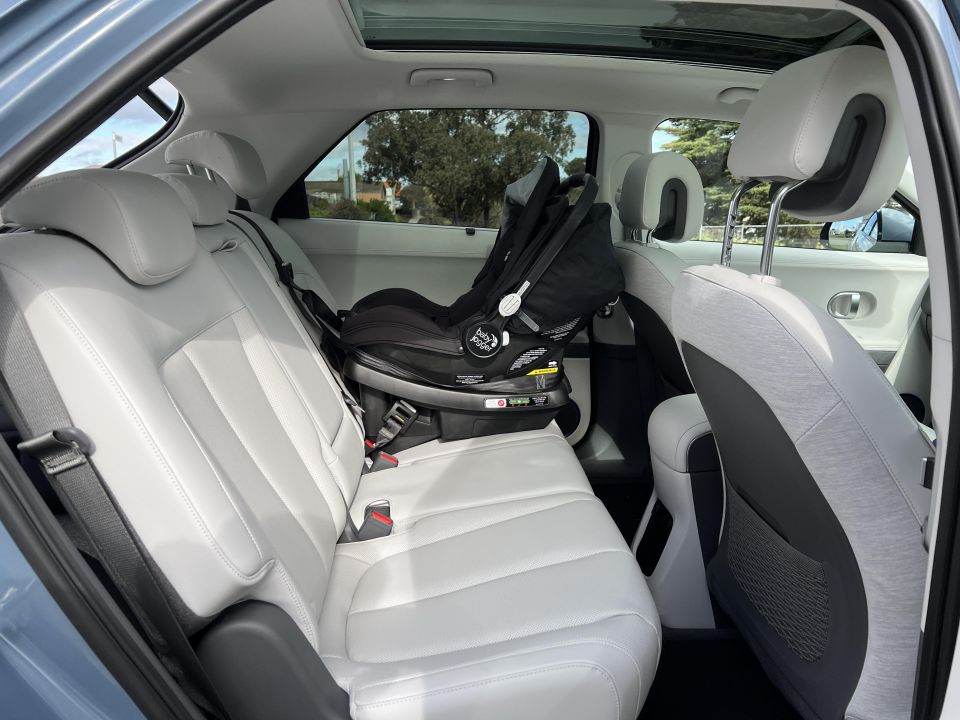


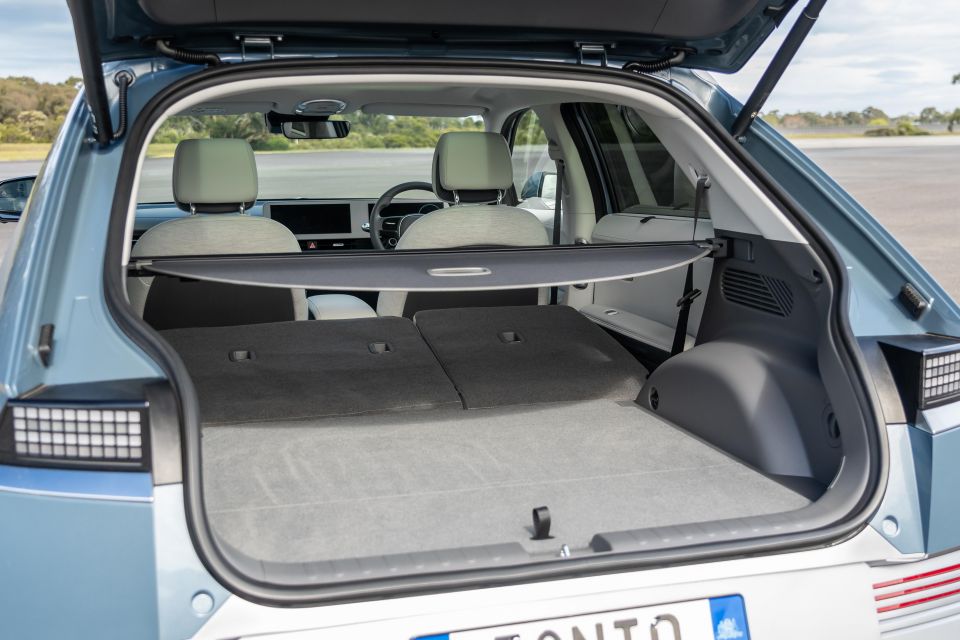
This means you need to move the passenger seat forward considerably to fit a baby seat, which reduces legroom in the first row. It’s not uncommon to need to do this, but my Model 3 has room in the first row to comfortably fit an adult when there’s a baby seat in the second row.
Despite its size, Hyundai has also dropped the ball on packaging when it comes to cargo space. The brand claims a storage capacity in the boot of 527 litres, but what you quickly notice is that the sloping tailgate eats into the usable space. If you want to use the cargo blind, space is reduced even further.
Beneath the cargo floor you’d expect a big storage space given there’s no spare tyre and no fuel tank, but instead most of the space is taken up by the subwoofer. Again, in my Model 3 there’s a huge sub-floor space for storage.
I put our pram in the boot of the Ioniq 5 and in our Model 3 as a comparison (see images further down) and despite being a smaller sedan, the Tesla had superior storage in the boot. Same story up front, where you can only fit a cable in the all-wheel drive version of the Ioniq 5 with just 24 litres of space available.
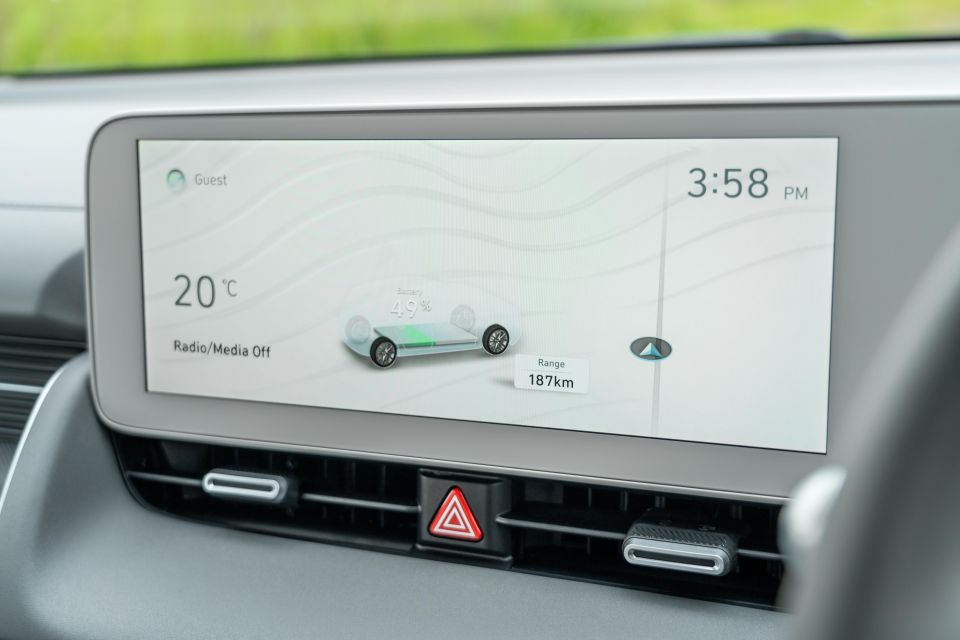
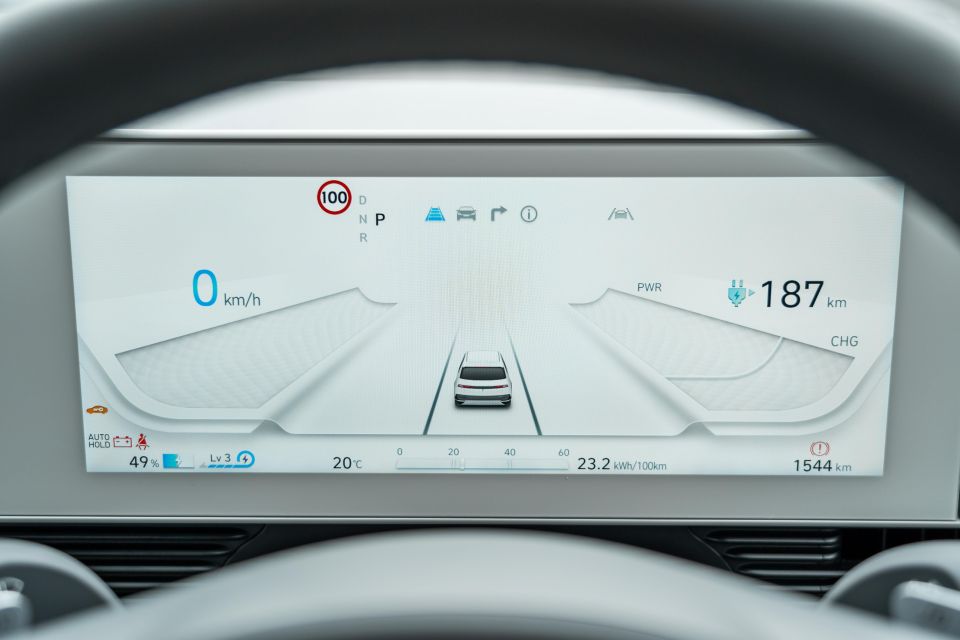
Outside of storage and practicality, the infotainment system will feel familiar to anybody that has driven a new Hyundai or Kia product. It’s easy to use and operates as a touchscreen with shortcut buttons on the panel beneath the air vents.
Reaching the top-left parts of the screen from the driver’s seat can be tricky at times given how far it is from your regular driving position. Making matters worse is the voice recognition function doesn’t do anything unless you have a smartphone connected via a cable with smartphone mirroring – there’s no wireless Apple CarPlay or Android Auto.
Most other cars in this segment offer native voice recognition for basic functions like radio selection, navigation entry and making calls. To safely enter a navigation destination without a smartphone connected, you really need a passenger to do the finger work or pull the car over.
There’s AM and FM radio, along with DAB+. It’s all plumbed through an eight-speaker Bose-branded sound system, which sounds great.
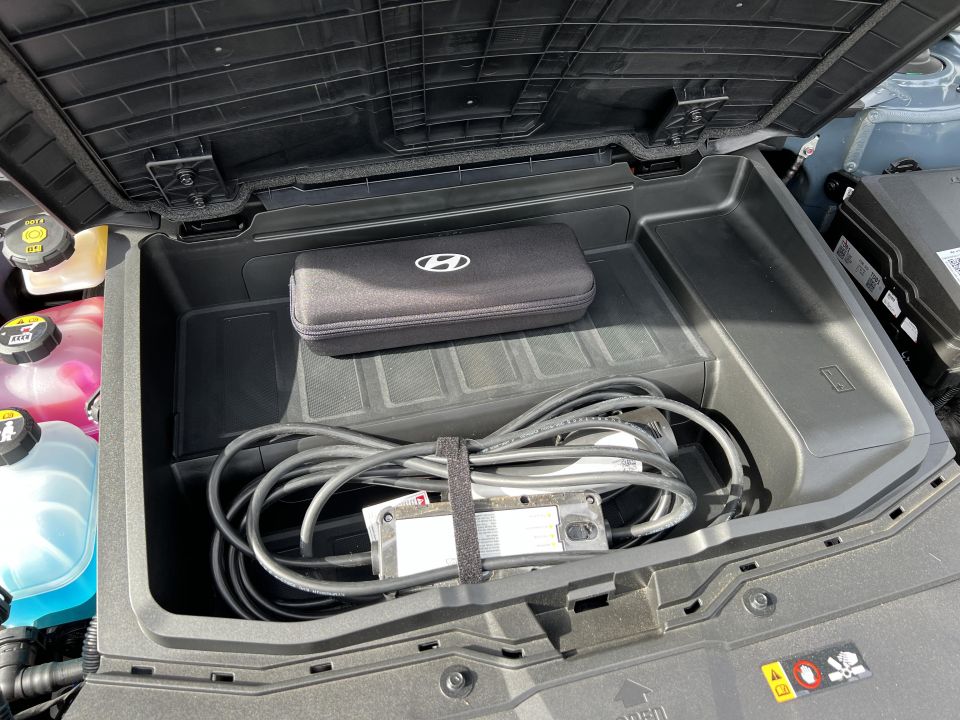
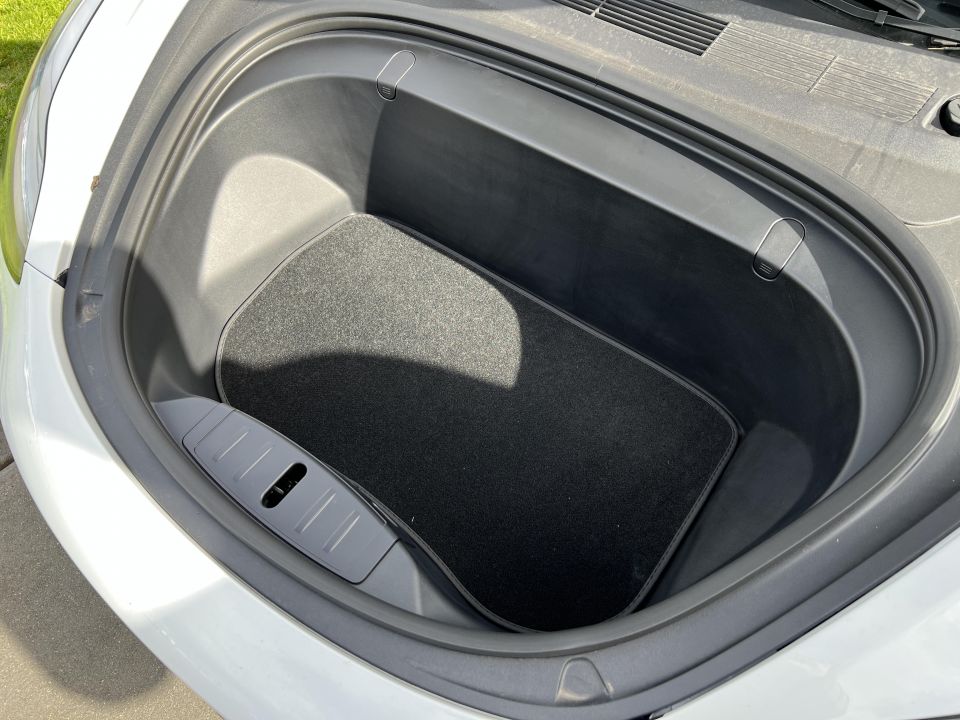
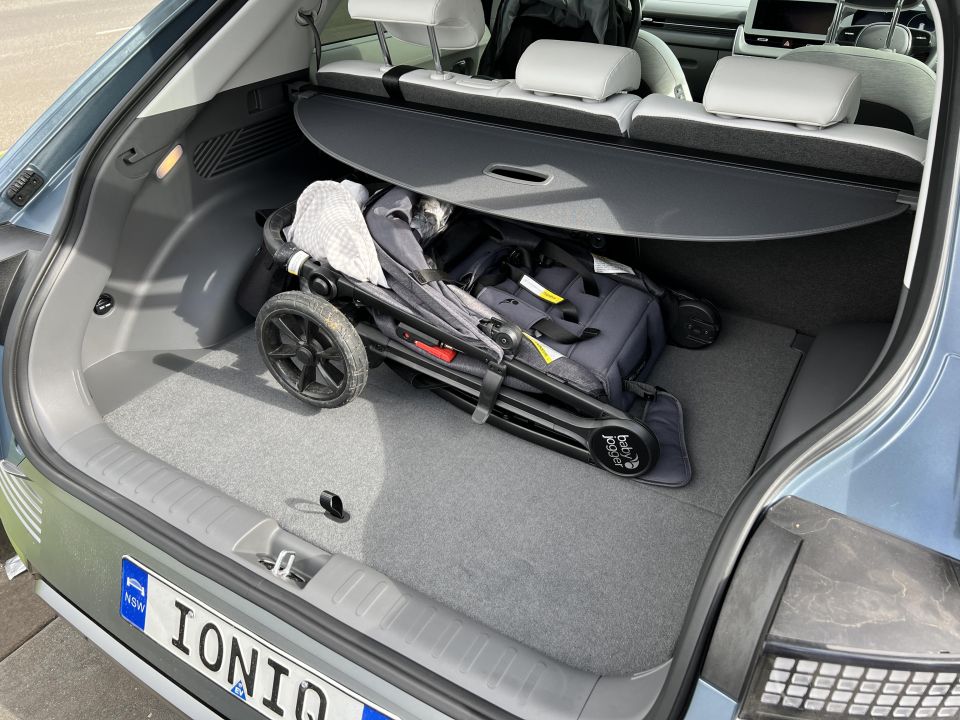
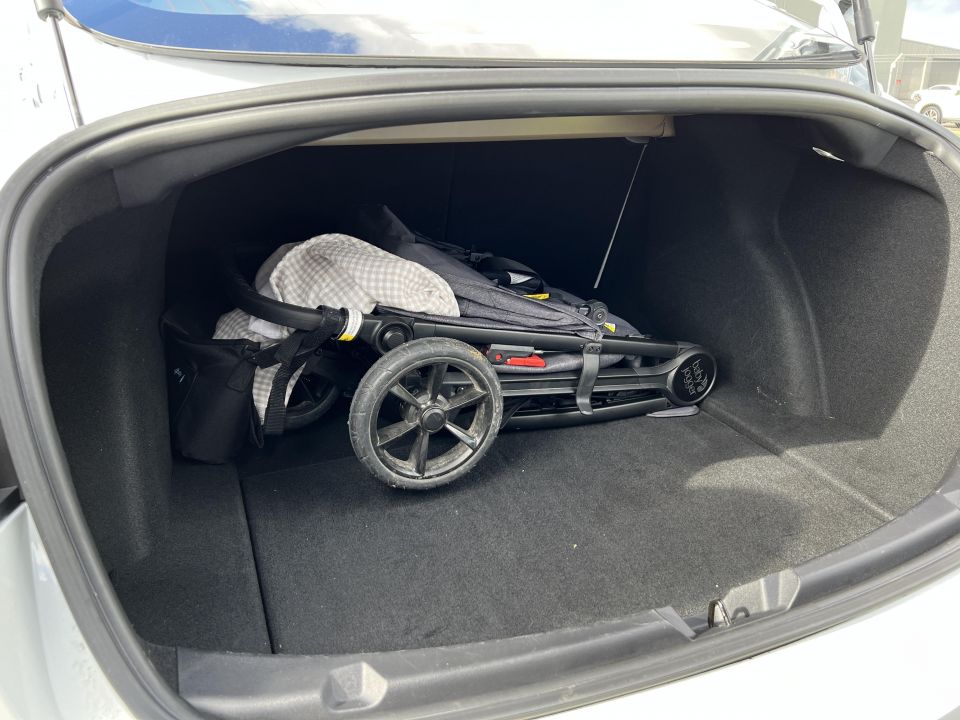
On charging and efficiency smarts, you are able to select a driver-only climate mode, which stops other climate zones from working to increase efficiency.
You can also schedule departure times to take advantage of cabin preconditioning, but a curious omission is not being able to set peak and off-peak charging times without a scheduled departure time.
You can remotely start cooling/heating using the remote, but the vehicle must be within visible range. Likewise there’s a remote parking feature activated by the key fob allowing the vehicle to drive out of or reverse into a parking space. There’s no application to remotely access the vehicle – we understand Hyundai is working to bring Blue Link to Australia, which adds functionality above and beyond the previously offered Auto Link application.
The interior has a super premium feel to it. If this wasn’t an electric car, which are typically more expensive than an equivalent internal-combustion vehicle, it would feel worthy of its price given the features, fit and finish, and presentation.
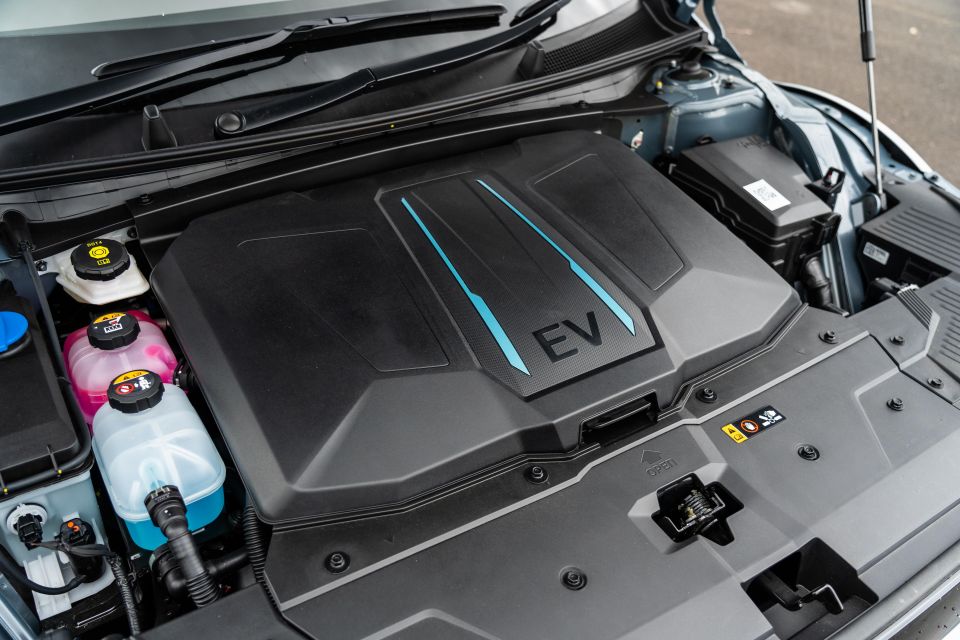
The 2022 Hyundai Ioniq 5 is available with a single-motor rear-wheel drive powertrain producing 160kW of power and 350Nm of torque, or a dual-motor all-wheel drive powertrain with 225kW and 605Nm. Both powertrains use a 72.6kWh lithium-ion battery.
The rear-wheel drive variant has a 0-100km/h time of 7.4 seconds, while the all-wheel drive model tested here does the sprint in 5.2 seconds.
The Ioniq 5 has a claimed range of 451km on the stricter WLTP standard in rear-wheel drive guise and 430km with all-wheel drive. It uses 17.9kWh/100km in the rear-wheel drive variant and 19.0kWh/100km in the all-wheel drive model.
It has 400V and 800V charging compatibility and can be charged at up to 11kW with three-phase AC power and up to 350kW with DC fast charging, the latter allowing you to charge it from 10 to 80 per cent in 17 minutes.
It also features a vehicle-to-load function that can provide up to 3.6kW of power.
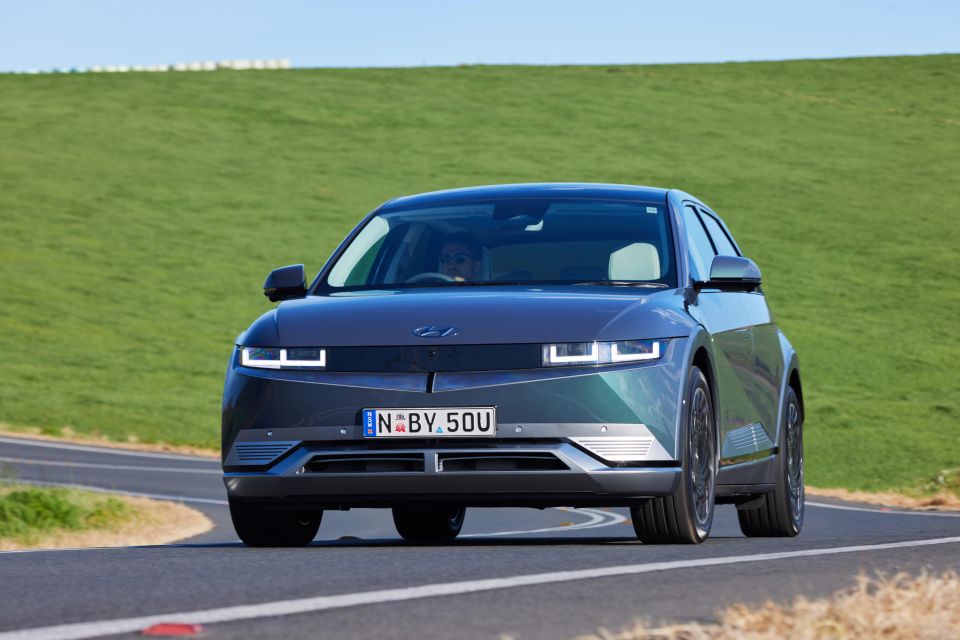
Before you hop into the car, the door handles sit flush with the body and electronically pop out when you approach with the key. To get in you pull the door handle and they return flush with the body when the vehicle drives off again.
Starting the Ioniq 5 is straightforward. You put your foot on the brake, hit the start button and it’s ready to go. A traditional gear selector has been ditched in lieu of a rotary stalk that sits under the indicator (which is on the right, by the way) – you twist it clockwise for drive, counterclockwise for reverse, and press a button at the end of the stalk for park.
Just like every other EV, the Ioniq 5 takes off silently. It has a low-speed pedestrian warning sound in drive and reverse.
Three drive modes adjust throttle sensitivity and regen sensitivity, with Eco, Normal, and Sport selected using a button on the bottom portion of the steering wheel.
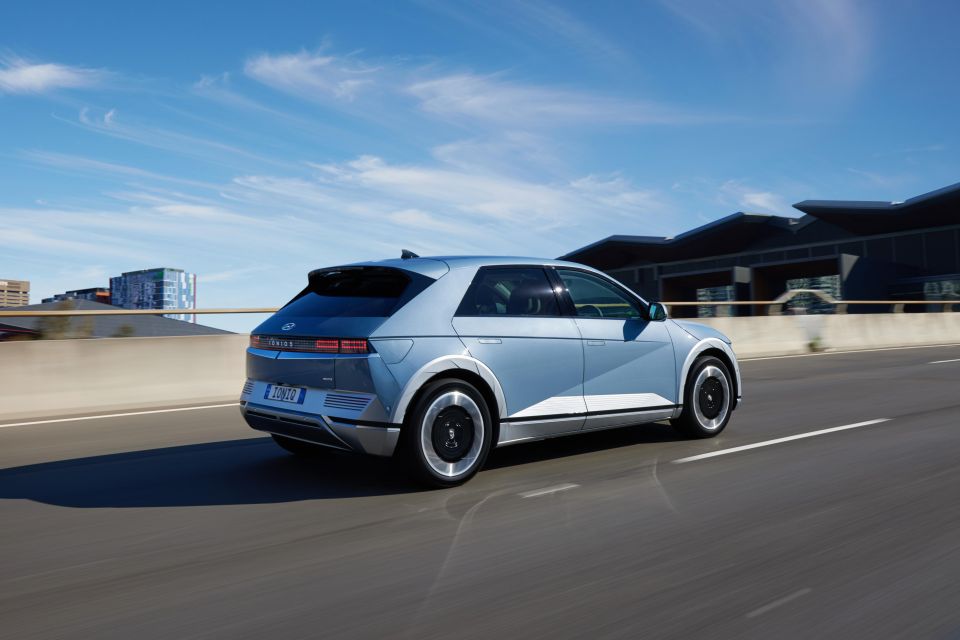
The driver can also select between four regen modes – no regeneration, through to the i-Pedal which mimics Tesla’s auto hold functionality or the e-Pedal in a Nissan Leaf. You can basically drive with just the throttle pedal.
As it slows down using regeneration, the vehicle comes to a complete stop without the driver using the left-hand pedal. Unlike the Leaf, which can be a little abrupt, the Ioniq 5 feels as good as the Tesla system and it becomes second nature after a while.
Frustratingly, it needs to be activated each time you restart the car or come out of reverse. And if you don’t take note that it’s not on it’ll surprise you as it doesn’t come to a complete stop when you slow down.
Around the city the Ioniq 5 feels compliant and very comfortable. It lacks adaptive damping, but despite this the ride is comfortable on its 20-inch alloy wheels. It’s zippy and the all-wheel drive system provides adequate traction across various weather and road conditions.
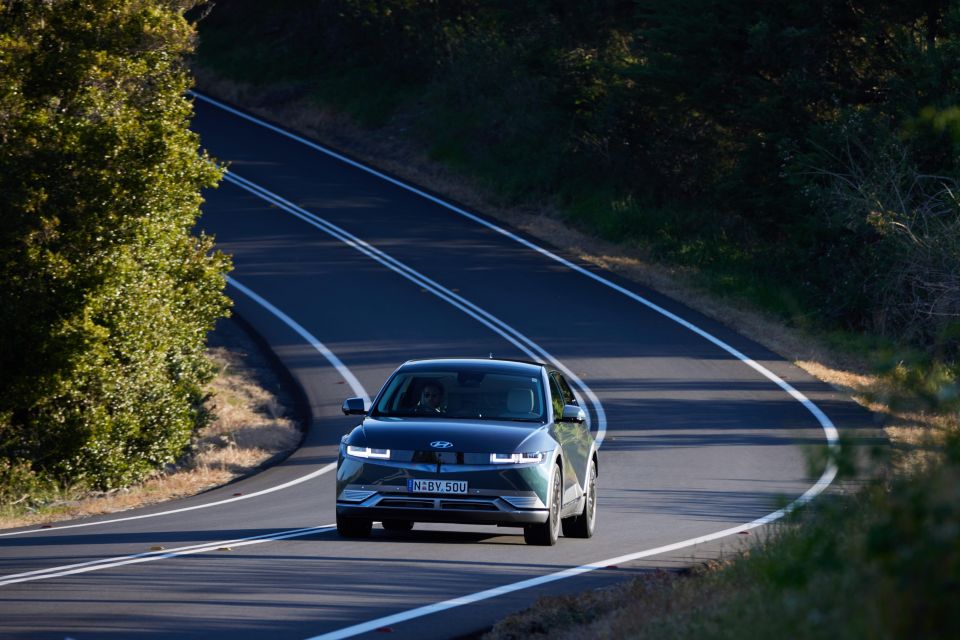
We had the chance to use a private test facility to explore the Ioniq 5’s capabilities up to 130km/h (maximum legal speed in Australia). The reason I point that out is because the ride and body control really starts to fall apart when speeds pick up.
A particular section of this road features the types of undulations you’d find on a typical country road and as the speed approaches 130km/h the lack of body control has the car staying in the air on rebounds far too long. This results in a wallowly feeling to the point where on the next consecutive set of undulations it will almost bottom out the suspension as it attempts to settle again.
This lack of body control is also evident as you hit bumps mid-corner. Again, typical of a country road at highway speeds. The long wheelbase also causes the body to unsettle as the car navigates a corner.
Generally this type of feeling behind the wheel comes when a carmaker goes with a soft suspension tune for comfort (in this case it was likely to round out firmness from 20-inch alloy wheels). It then becomes unstuck when it’s met with road conditions where it can’t settle in time for the next disturbance.
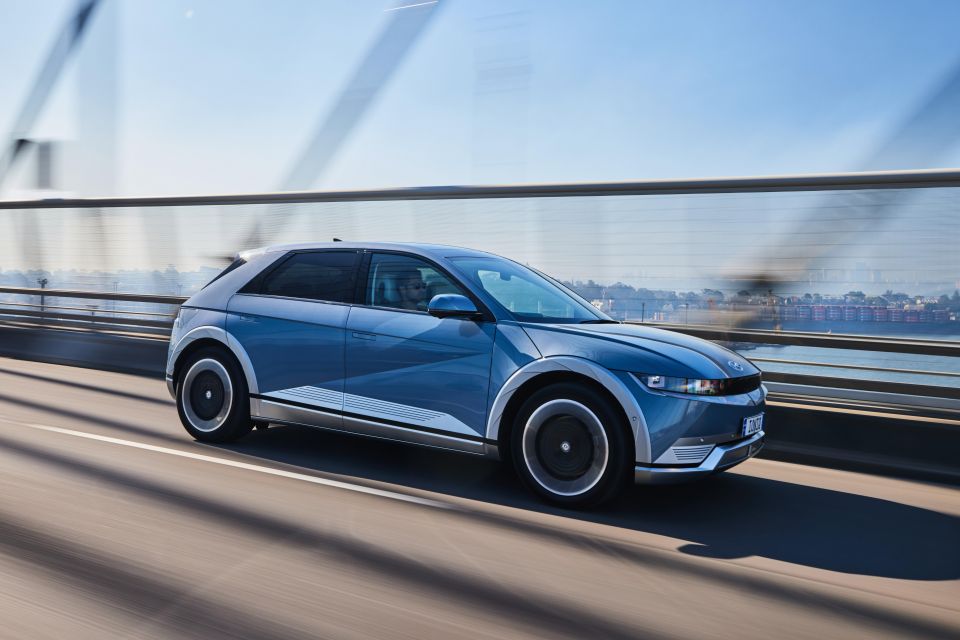
Like the all-new Tucson and Staria (both of which we tested on this specific circuit at the same speeds), Hyundai hasn’t performed any local ride and handling tuning. It wasn’t an issue in the Tucson or Staria, but the Ioniq 5 needs some work to meet Australian road conditions. You can check out our video reviews of the Tucson, Staria and Ioniq 5 to compare what they look like on the same stretch of road at the same speeds.
If you’re planning on driving the Ioniq 5 in the city, you’re unlikely to ever notice these flaws. But once you load the car up and hit the road, you’ll find it just doesn’t have the body control of other Hyundai products.
Outside of the ride issue, the Ioniq 5 does all the fun EV stuff you’d expect. It has instant throttle response and straight line acceleration feels quick across its speed band.
Visibility out the front, sides and rear is great. My personal favourite feature of new Kia and Hyundai products is the Blind Spot View Monitor, which relays a video feed from the sides of the vehicle into the digital instrument cluster when the indicator is selected. It teams with conventional blind-spot sensors in the wing mirrors to make sure you’re never going to miss somebody in your blind spot.
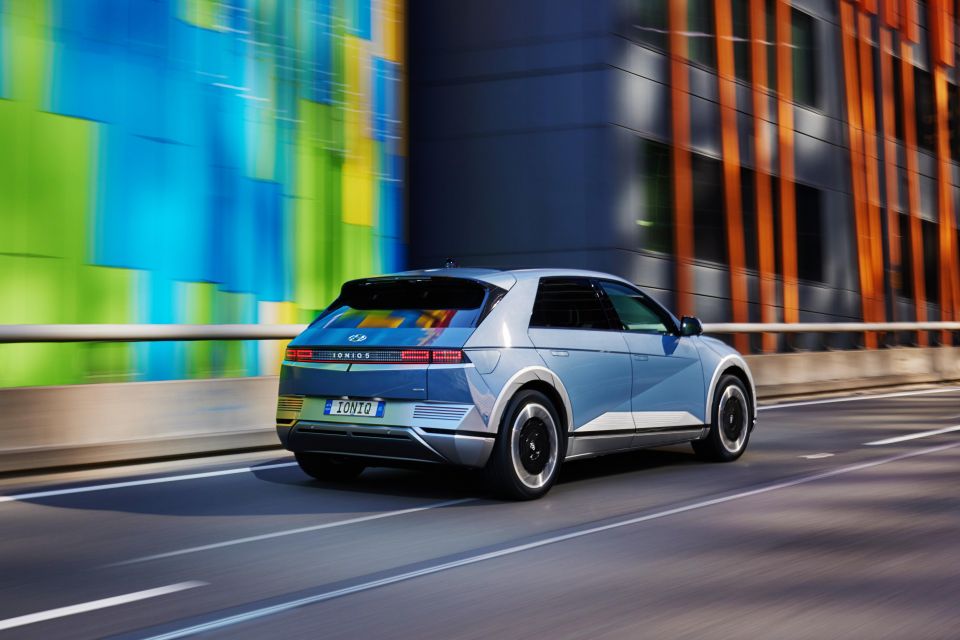
Where expert car reviews meet expert car buying – CarExpert gives you trusted advice, personalised service and real savings on your next new car.
On the efficiency front, we averaged 19.9kWh/100km during our time with the car. We ended up doing around 600km over a mix of highway and city driving, as well as performance testing.
While the radar cruise control works well, we found the lane-keeping assistant and semi-autonomous steering function to be hit and miss. The system will sometimes deviate out of the lane on turns at highway speeds and can lose track of lines on country roads with poor line quality.
It’s worth pointing out as well that the Ioniq 5 uses a patented inverter technology that allows it to scale up to 800V charging on a DC fast charger. This allows for charging at up to almost 250kW, which matches the best in the segment.
It’s also one of the few EVs that allow power to exit the vehicle and be used to run other devices. Using a dongle that plugs into the Type 2 charge port, it offers a 15A domestic plug that outputs up to 3.6kW of power at 240V, which is more than enough to run a raft of appliances at a campsite or worksite.
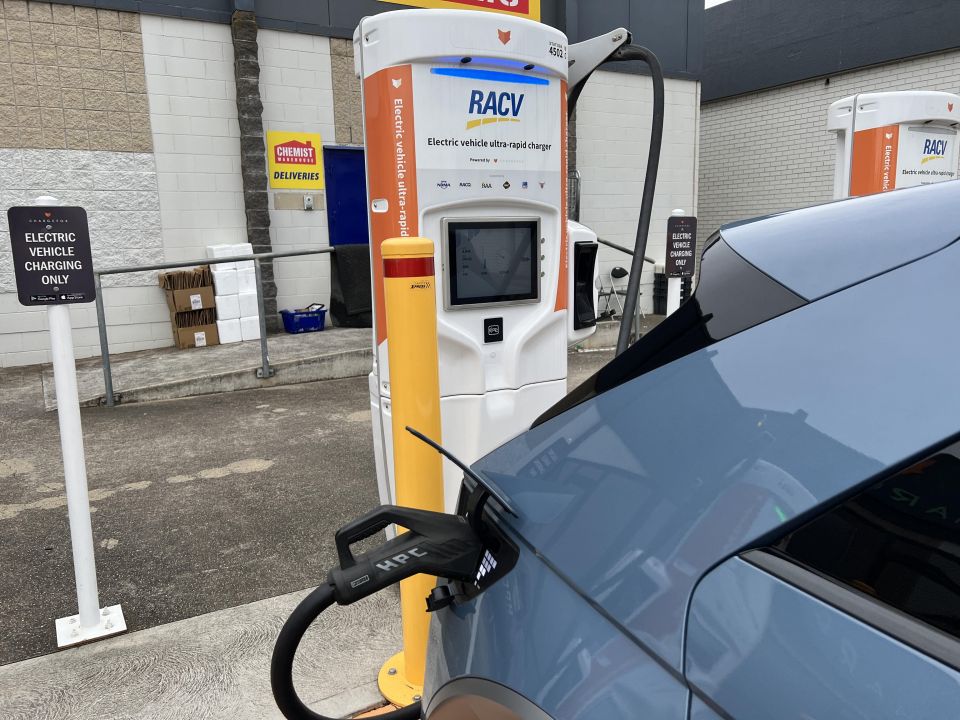
Hyundai covers its range with a five-year, unlimited-kilometre warranty.
The Ioniq 5’s battery is covered for eight years of 160,000km, whichever comes first.
Servicing is required every 12 months or 15,000km, whichever comes first. The first five services are capped at $220 for both variants, but for the fourth service which costs $804.
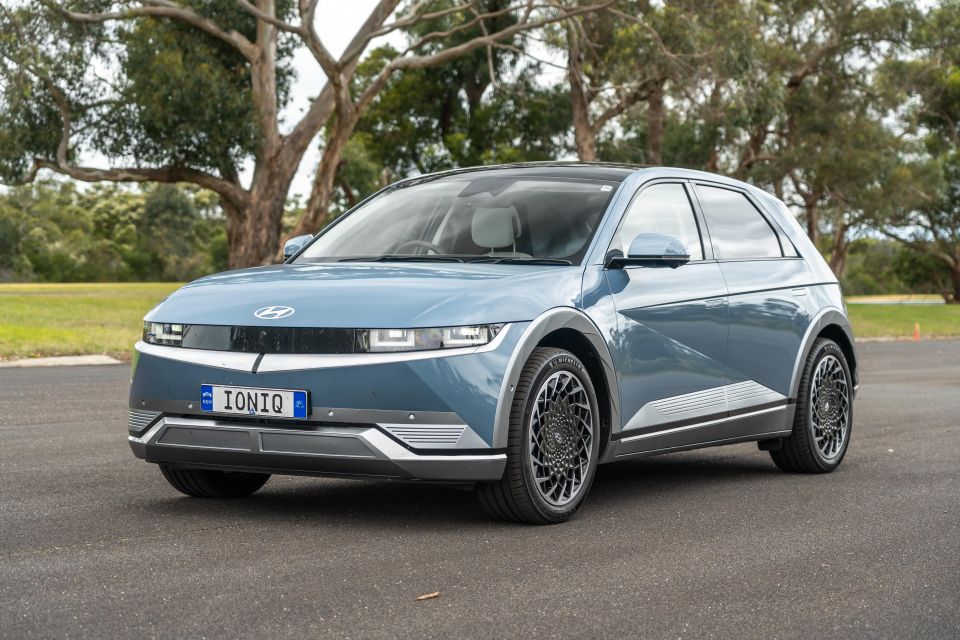
What Hyundai has been able to do in the EV space in such a short time is pretty impressive. It has developed a bespoke platform with efficient motors, exceptional straight-line performance, and a driving experience that doesn’t make it feel like a science project, but just a normal car.
It’s not without its flaws, though. Cargo packaging is pretty average – ultimately it’s what makes me want to hold out for the Kia EV6 or Tesla Model Y before we commit to getting rid of our Model 3.
I also wasn’t impressed with the handling. I understand it’s not marketed as a sports car, but even with that in mind it doesn’t fill me with confidence as speeds pick up and if you enjoy going for a fun drive every now and then, it doesn’t put a smile on your face like other EVs in this price bracket.
But if those things aren’t important to you, the Ioniq 5 is a really cool-looking EV that comes loaded with every feature you could want. It feels premium inside and out, it’s efficient, and comes with the tools you need for fast charging and V2L.
There are a raft of EVs coming to Australia over the next 12-18 months and buyers will soon be spoilt for choice, which may not be great news for the Ioniq 5 but it’s only good news for consumers. Check out our EV Launch Calendar here.
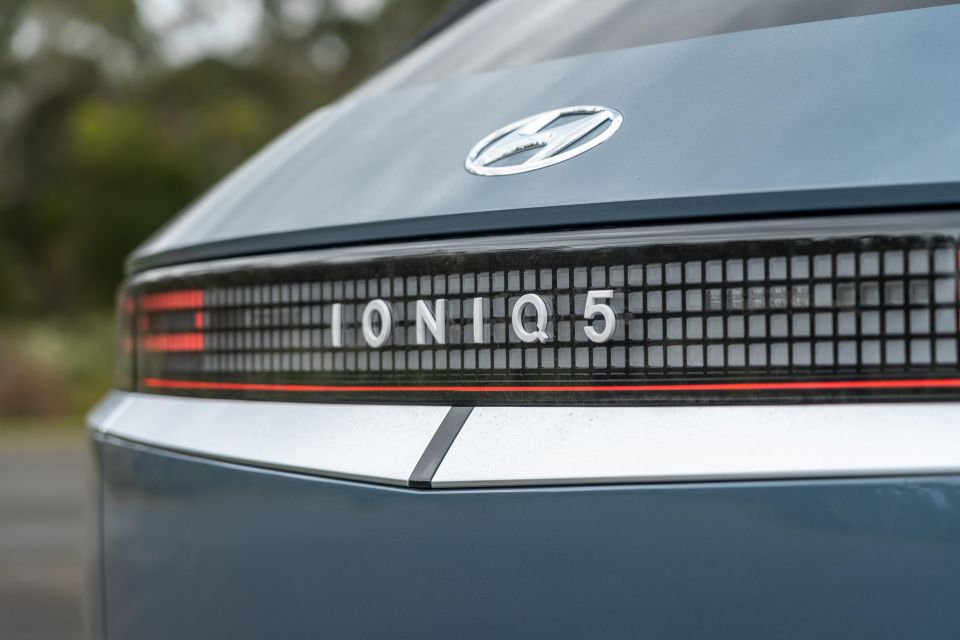
Click the images for the full gallery
Where expert car reviews meet expert car buying – CarExpert gives you trusted advice, personalised service and real savings on your next new car.
Paul Maric is an Australian car expert based in Melbourne, Australia. Paul is a founder of CarExpert.com.au & formerly part of the CarAdvice founding team.


Andrew Maclean
1 Month Ago
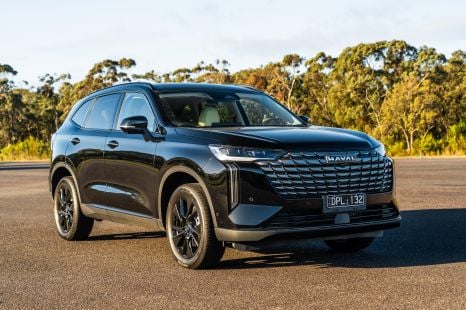

Josh Nevett
1 Month Ago
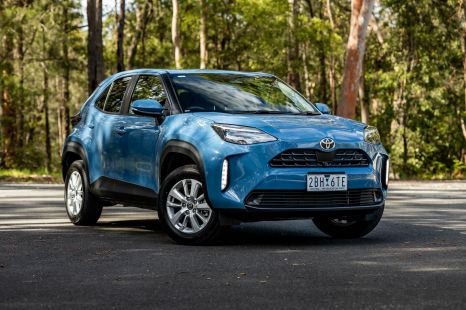

Matt Campbell
24 Days Ago
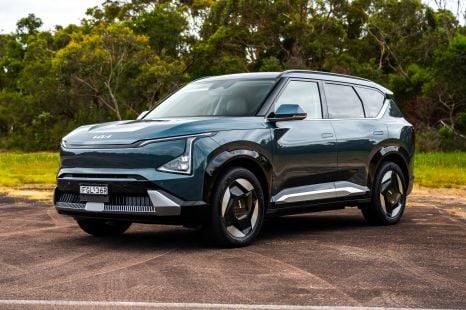

James Wong
17 Days Ago
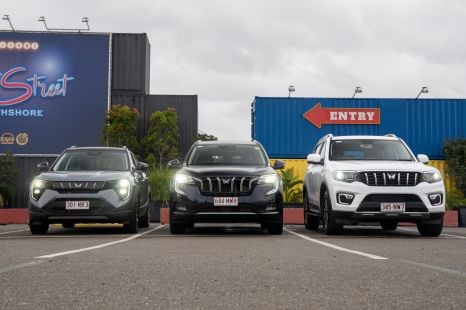

CarExpert.com.au
10 Days Ago


CarExpert.com.au
9 Days Ago